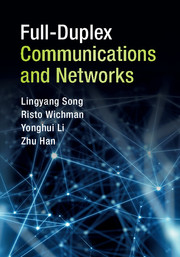Book contents
- Frontmatter
- Dedication
- Contents
- Preface
- 1 Basics of Communication Systems
- 2 Signal Processing and Theoretical Limits
- 3 Full-Duplex System Hardware Implementation
- 4 Full-Duplex MIMO Communications
- 5 Full-Duplex OFDMA Communications
- 6 Full-Duplex Heterogeneous Networks
- 7 Full-Duplex Cooperative Networks
- 8 Full-Duplex Cognitive Radio Networks
- 9 Full-Duplex Random Access Networks
- References
- Index
8 - Full-Duplex Cognitive Radio Networks
Published online by Cambridge University Press: 16 March 2017
- Frontmatter
- Dedication
- Contents
- Preface
- 1 Basics of Communication Systems
- 2 Signal Processing and Theoretical Limits
- 3 Full-Duplex System Hardware Implementation
- 4 Full-Duplex MIMO Communications
- 5 Full-Duplex OFDMA Communications
- 6 Full-Duplex Heterogeneous Networks
- 7 Full-Duplex Cooperative Networks
- 8 Full-Duplex Cognitive Radio Networks
- 9 Full-Duplex Random Access Networks
- References
- Index
Summary
With the proliferation of wireless services and the ever increasing data rate demands, spectrum resources have become more and more scarce. As a promising technique to increase the efficiency of spectrum utilization, Cognitive Radio (CR) has great potential to meet such a requirement by allowing unlicensed users (Secondary Users, SUs) to coexist in licensed bands allocated to licensed users (Primary Users, PUs). In conventional CR systems, the spectrum sensing is performed at the beginning of each time slot before the data transmission, which is also known as the “listen-before-talk” protocol. While this protocol has worked well in CR networks, two inherent problems still exist: 1) transmission time reduction due to sensing, and 2) sensing accuracy impairment due to data transmission.
While a great many works have discussed the design of sensing interval and duration to minimize the impact of the above problems, we, on the other hand, manage to apply FD technology to CR networks to bypass the problems. Specifically, FD technology enables simultaneous sensing and transmission for SUs. In other words, neither sensing nor data transmission needs to be interrupted by the other. In this way, SUs can react promptly to the PUs’ access and departure, and possibly fully utilize spectrum opportunities for data transmission.
In this chapter, we first provide some preliminaries of cognitive radio and some existing works. Then, we elaborate the proposed FD CR protocol, named the “Listen- And-Talk” (LAT) protocol, and provide detailed analysis about the parameter design and a unique trade-off between secondary transmit power and secondary throughput. Based on the basic LAT protocol that evolves only one pair of SUs, we extend the scenario to cooperative spectrum sensing and dynamic spectrum access, respectively, in the next two sections. Finally, we list some key challenges in the design and implementation of FD CRNs.
Cognitive Radio Basics
The existing and new wireless technologies, such as smart phones, wireless computers, and WiFi home and business networks, are rapidly consuming the radio spectrum. Unlike the wired Internet, the wireless world has a limited number of links to distribute. The usage of radio spectrum resources and the regulation of radio emissions are coordinated by national regulatory bodies like the Federal Communications Commission (FCC). These bodies assign spectrum to licensed holders, also known as Primary Users (PUs), on a long-term basis for large geographical regions.
- Type
- Chapter
- Information
- Full-Duplex Communications and Networks , pp. 247 - 290Publisher: Cambridge University PressPrint publication year: 2017



